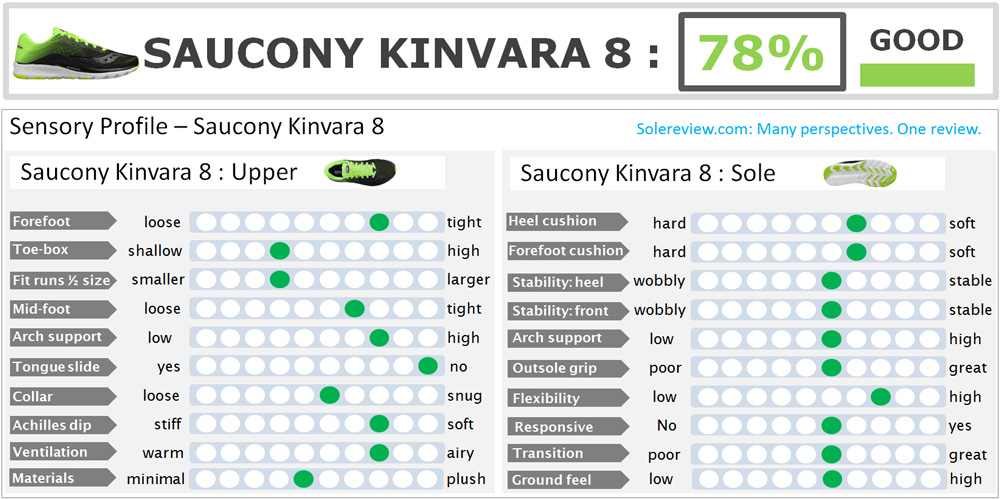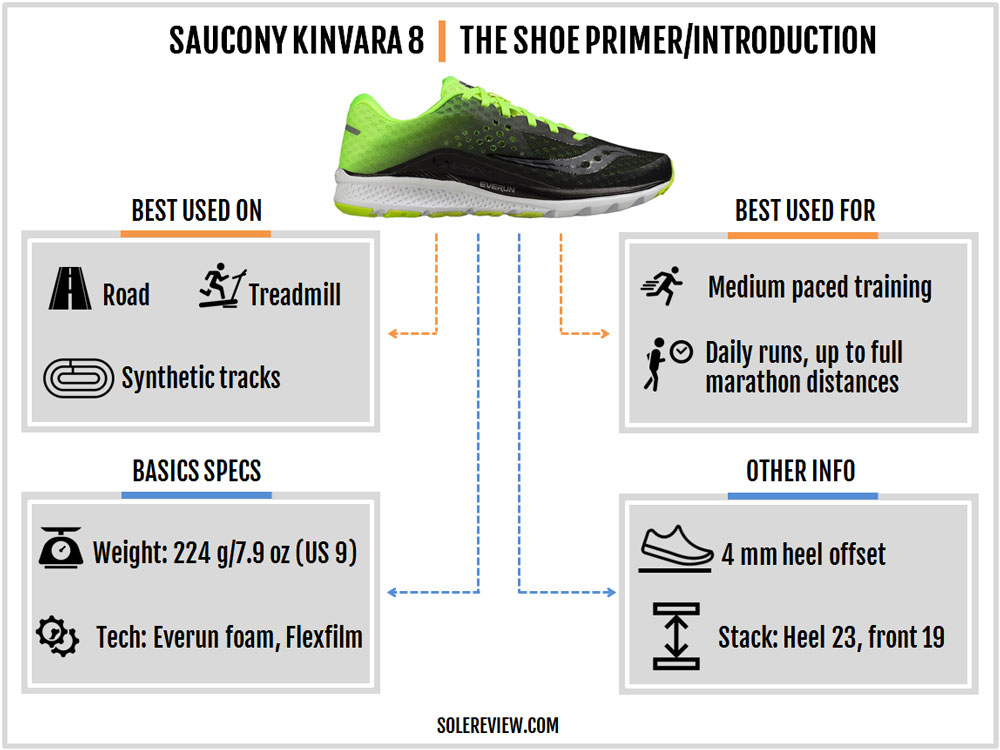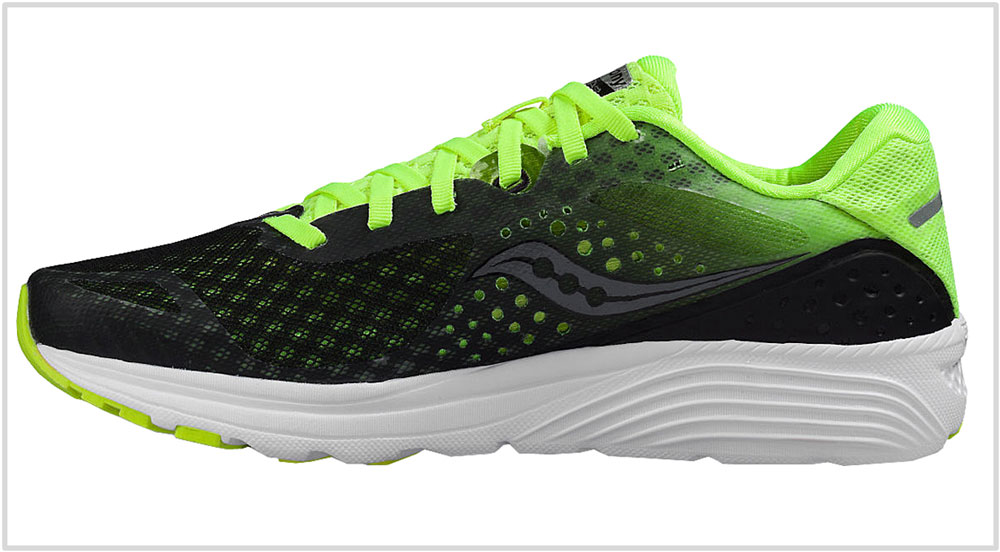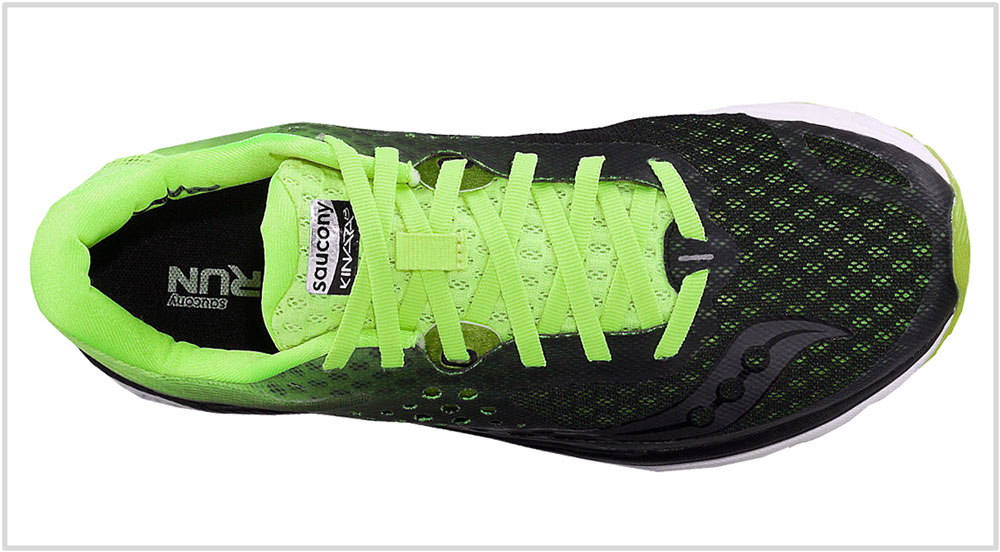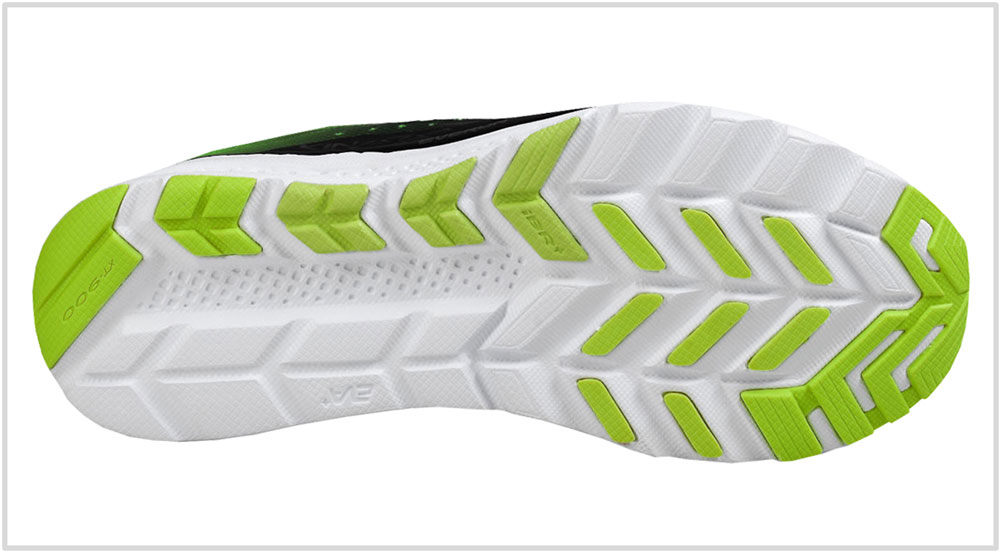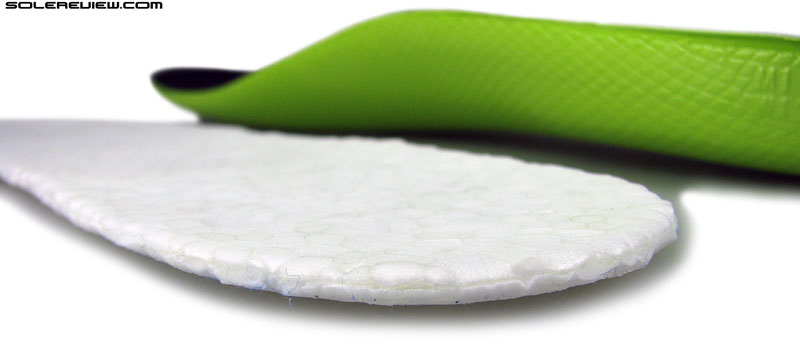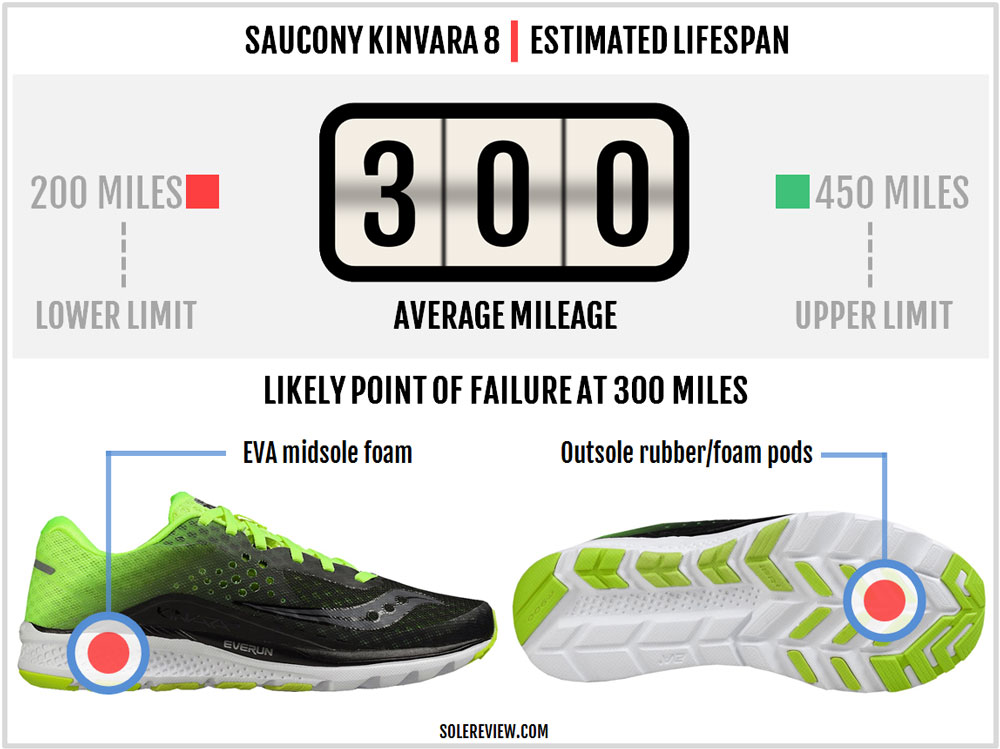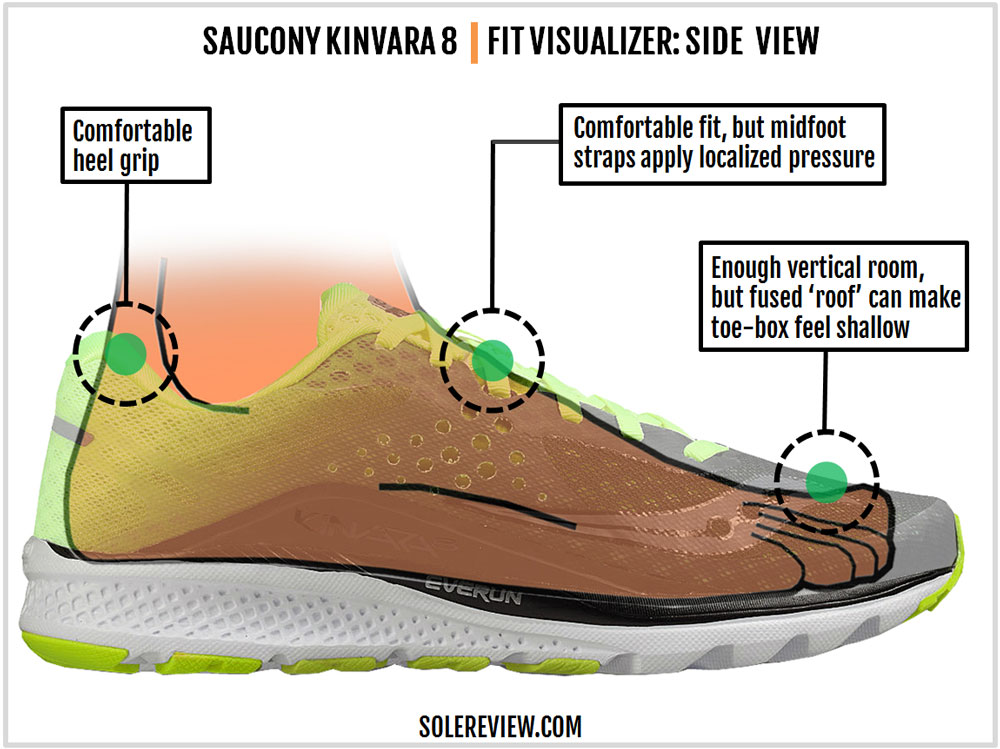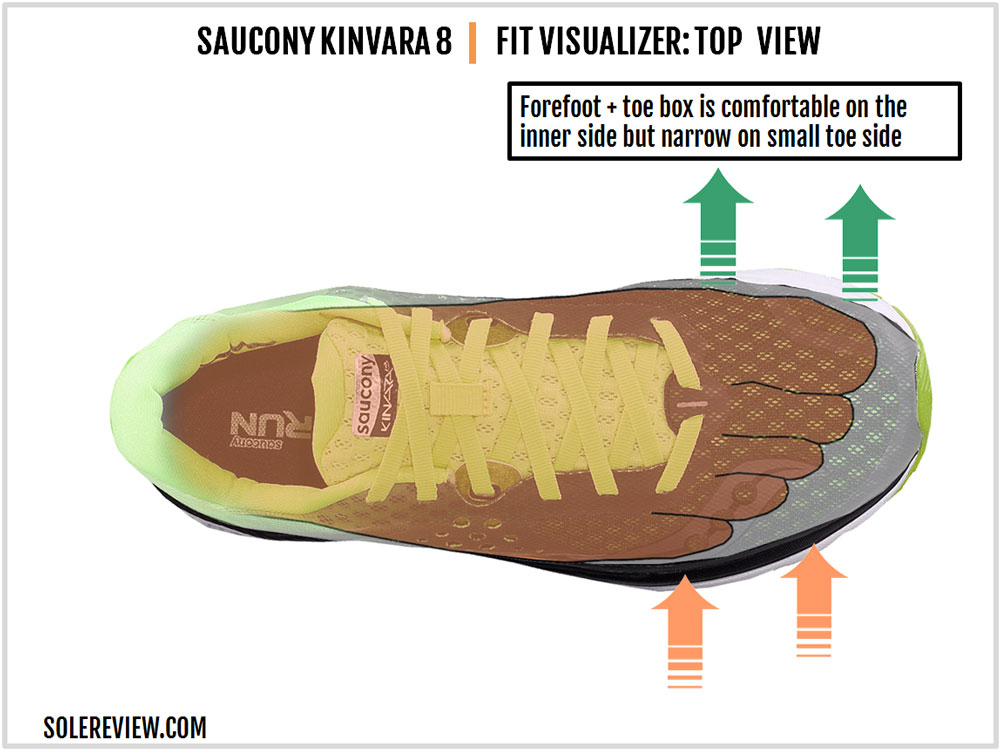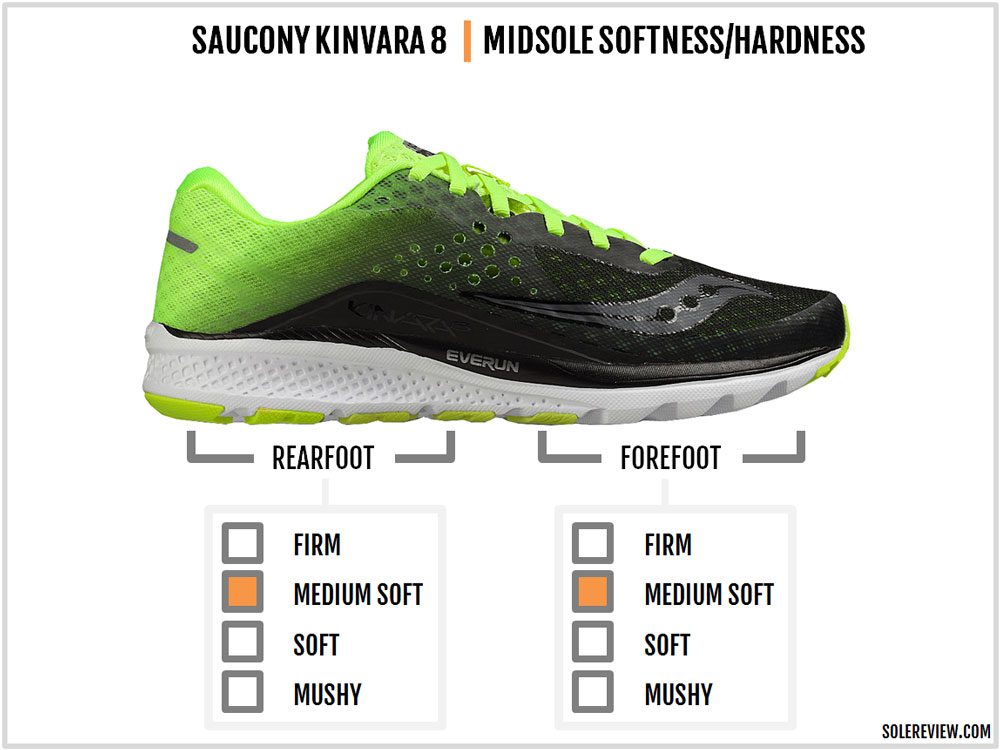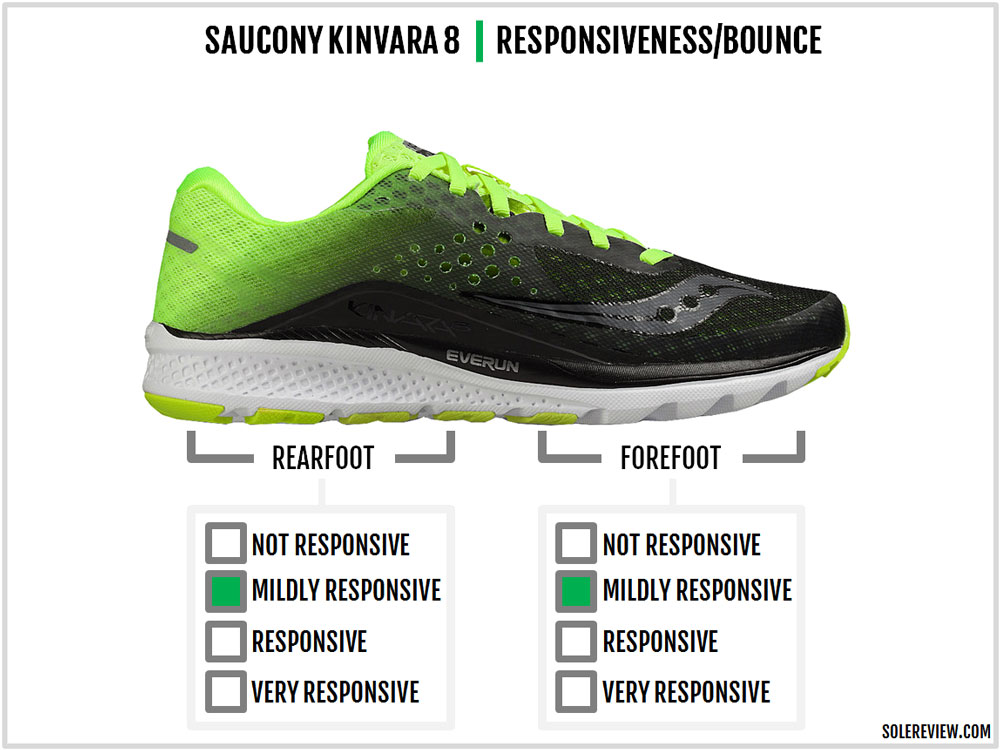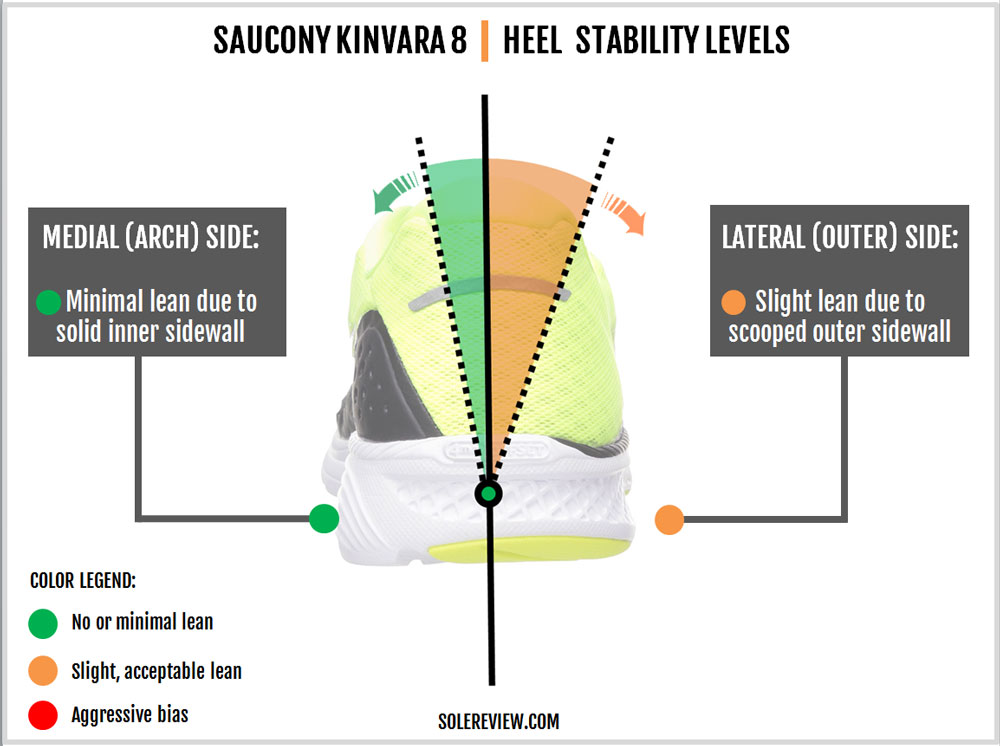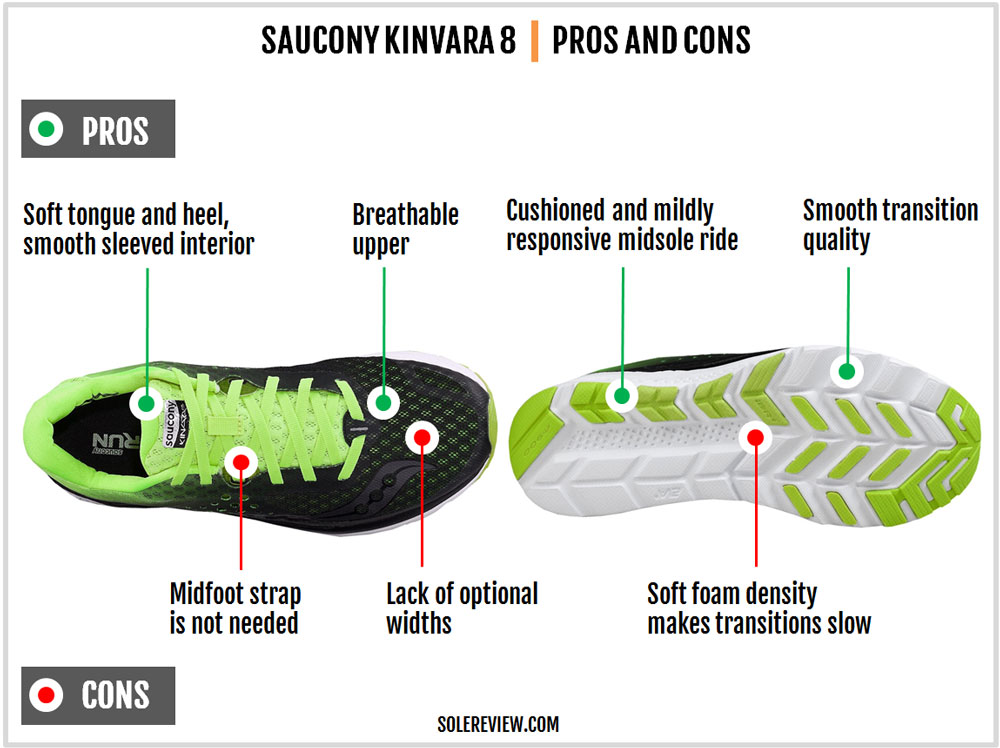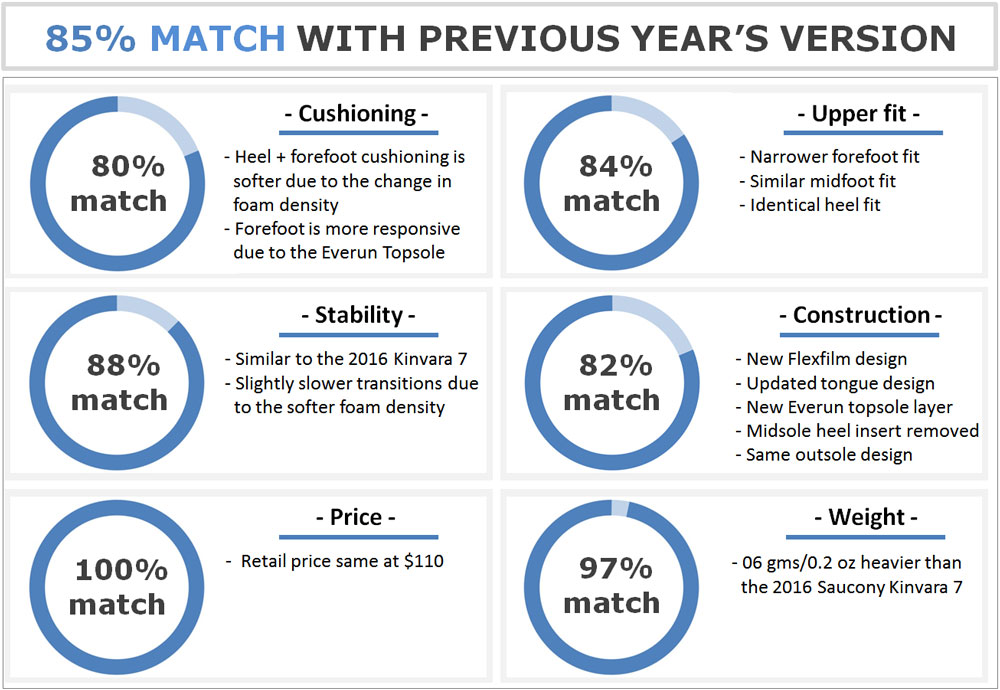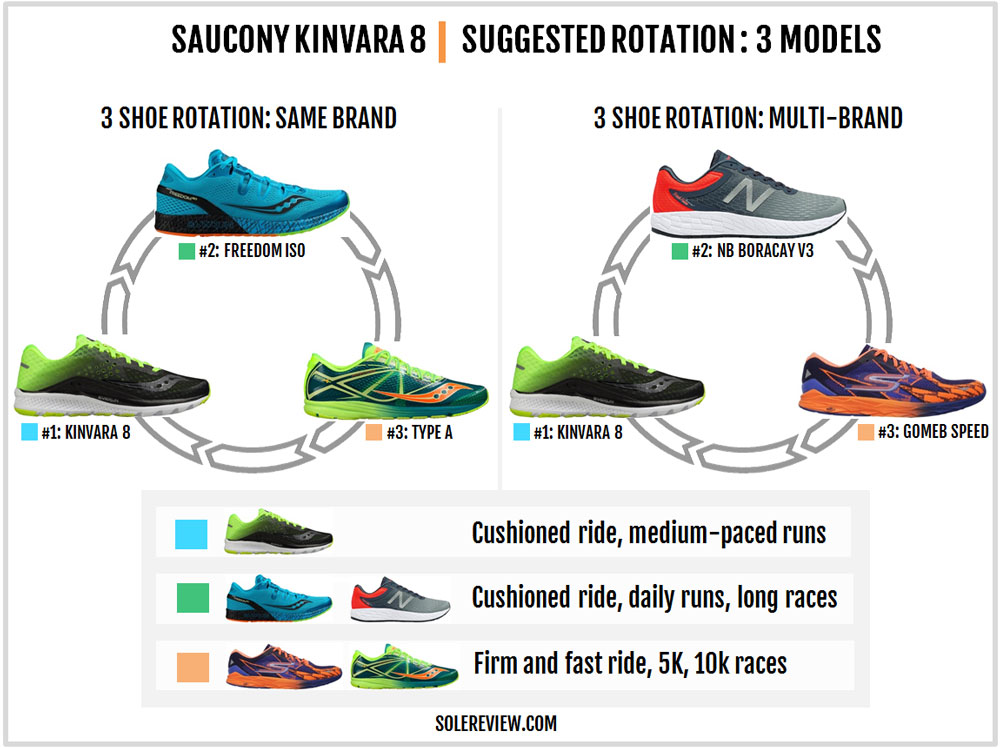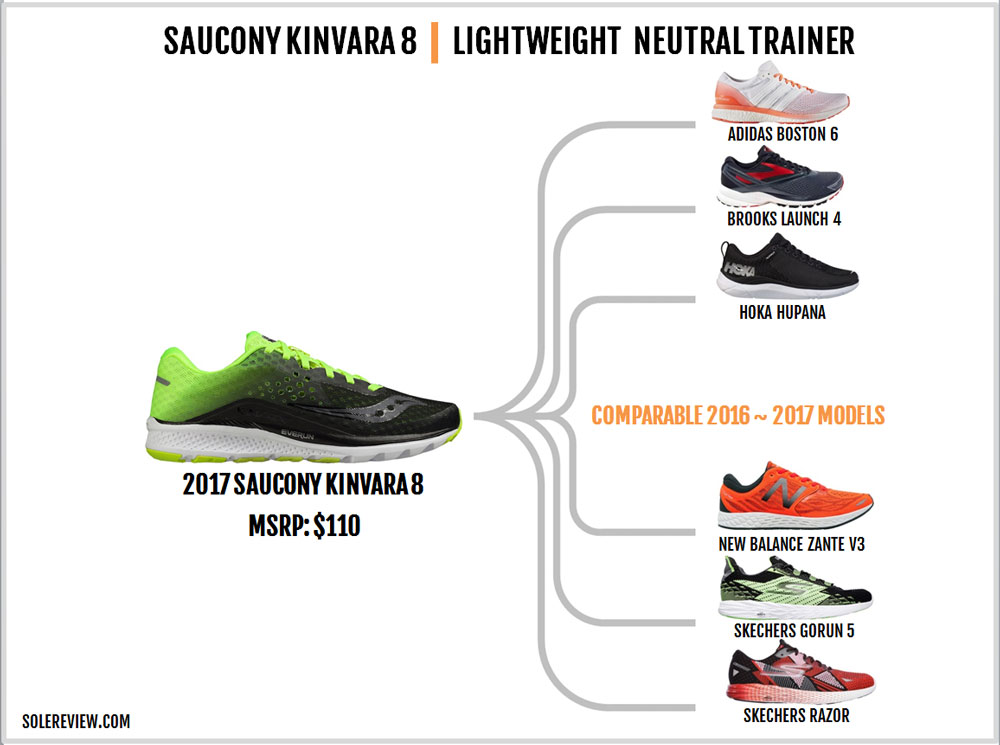INTRODUCTION
How time flies. It’s been five years since solereview first tested the Kinvara. While it was the third version, the model was an important milestone for the Kinvara series. The Kinvara 3 was the first in its line to feature the ‘Flexfilm’ upper – a fancy name for using thin, fused layers over the upper.
Later models have continued the use of Flexfilm in different variations, which also includes the latest Kinvara 8. But besides the Flexfilm, a lot has changed since the original Kinvaras.
In retrospect, it’s easy to see why the Kinvara survived the short-lived era of footwear minimalism. Models like the Kinvara 3 and 4 provided a fast and economical ride without being either too mushy or too hard; the shoes were cushioned enough to go a certain distance but provided a firm feel conducive for fast training.
In other words, runners loved the Kinvara for its versatility.
The midsole with its 4 mm offset also proved to be the perfect middle ground between zero drop midsoles and traditional trainers with their 8-12 mm differential. It won’t be far-fetched to say that the Kinvara is an embodiment of the 4 mm drop category. Think of a 4 mm offset midsole, and the chances are that you’ll see a mental image of the Kinvara.
The Kinvara 5 was a pivotal point in the shoe’s evolution. The upper acquired a pair of new ‘Pro-lock’ midfoot straps, and the ride turned softer. This was a Kinvara keeping up with the changing times, as consumer tastes evolved from barefoot minimalism to cushioned hedonism.
In short, the Kinvara became closer to a traditional cushioned trainer when compared to its earlier editions.
There’s some feedback that the Kinvara 8 is closer to its original roots (K3, K4), but we disagree. While the 2017 Kinvara 8 is a better shoe than the Kinvara 7 in a few ways – for example, the ride is smoother and the upper loses a lot of layering – the latest Kinvara still stays a lightweight softy.
What’s new for the 2017 model? The Kinvara 8 uses the same midsole and outsole as the 7, except that the midsole is overlaid with an Everun ‘topsole,’ and the foam density is softer. The upper goes more minimal as it cuts down on the amount of external layers.
Both the midsole and upper changes come with performance updates, all of which we’ll cover in the review which follows.
DESIGN AND MATERIALS
All Kinvaras starting with the version 3 have used the fused ‘Flexfilm’ based uppers. The use of thin layers is one of the reasons why the Kinvara has managed to stay at around 8 ounces (230 grams).
Many years ago, the Flexfilm had some teething issues, but of late the fused construction has proven to be as hardy as uppers with stitched-on layers.
One of the changes on the Kinvara 8 vs. the 7 is a cleaner upper profile. The Kinvara 8 uses Flexfilm, but there’s less of it. Also, the fused layers used on the K8 has a translucent quality which blends in perfectly with the mesh below. In contrast, the Flexfilm seen on earlier Kinvara models stood out as distinct components, making the upper seem busy.
The Kinvara 8’s forefoot is kept relatively free of the Flexfilm – if you remember, the K7 had these twin strips connecting the lacing area to the toe-box. But there’s a new feature on the Kinvara 8’s toe-box. There is a ‘roof’ of sorts (made out of Flexfilm) which is located right over the big-toe.
While this ‘roof’ or canopy is undoubtedly placed to improve the mesh durability, runners transitioning from the K7 might find the toe-box shallower. This is a brand new design feature for the Kinvara. The rest of the toe-box is reinforced with the Flexfilm, as it was on the earlier models.
It’s not just the reduced usage of Flexfilm which makes the Kinvara 8 appear sleeker. The K7 used multiple mesh textures over its surface which made the shoe look cluttered; the Kinvara 8 sticks to a single texture and reinforces it with Flexfilm wherever needed.
For example, the midfoot is layered with Flexfilm with holes for ventilation. The lacing area is strengthened with Flexfilm too, and the eyelets are integrated into it.
One of our Kinvara review contributors had an interesting observation: The eyelets punched into the Kinvara 8 are flat in shape, and go much better with the flat laces. In contrast, all the Kinvara models we’ve reviewed thus have had round eyelets and flat laces.
This small change makes for a better lacing experience, and the flat laces pass smoother than the past Kinvaras.
Saucony removes the ‘Prolock’ strap on the tongue but retains the inner side straps. These twin straps hug the midfoot on either side, and are located between the outer upper and the sleeve.
The Kinvara 8 has a partial sleeve, like the K5, K6, and the K7. And as the result of the tongue strap removal, the Kinvara 8’s tongue is softer.
Not a lot has changed around the heel collar except for a couple of small updates. The heel is made of the soft ‘Rundry’ lining, and the foam packed inside makes the fit comfortable.
Compared to the Kinvara 7, the inner collar is slightly firmer as the Flexfilm extends further towards the heel. The reflective trim gets a redesign and now is a long strip over the heel center. Like all the past Kinvara models, you get the last row of heel-lock lacing.
We observed that the Kinvara 8’s upper is better ventilated than the 7. That’s due to the judicious use of Flexfilm, and the open-pored mesh which breathes better. This economy of design also allows the Kinvara 8’s upper to flex better than the 7.
From the outside, the Kinvara 8 seems to have an identical midsole and outsole as the 7. It does, but there are a few changes inside.
The Kinvara 7 had a thin heel Everun foam insert, based on a placement similar to the earlier ‘Powergrid’ equipped Kinvara models. For the 2017 Kinvara 8, Saucony opts for a full-length Everun topsole (picture below), a design also used on the Guide 10 and Ride.
A removable molded insole is placed above the Everun Topsole, and the main midsole is made of EVA foam. While the midsole design is the same as the Kinvara 7, the Kinvara 8 uses a softer foam density.
The outsole stays the same – there are small pieces of blown-rubber strips inset into the forefoot, and the heel crashpad has a harder rubber compound. The rest of the outsole has exposed midsole foam, including the outer forefoot. The placement of rubber on the forefoot is in a ‘Chevron’ formation, which was first seen on the Triumph ISO 2.
Due to the softer foam density, the Kinvara 8 performs well on forefoot flexibility, and slightly better than the Kinvara 7. The weight saving design of the upper and the outsole helps the K8 maintain its weight at 7.9 oz/224 grams, which is 0.2 oz heavier than the K7.
The Kinvara has never been a super-durable shoe. Even the early editions of the K-shoe were miserly in their use of outsole rubber, and that hasn’t changed. The K8 has just enough outsole rubber to last a few hundred miles; the range is going to be around 300 miles, or more if you’re light-footed and run in colder temperatures.
It’s also important to note that while the Kinvara 8 uses durable Everun foam, it only forms a small part of the midsole. The rest of the foam stack is lightweight injection-molded EVA foam, which means it is susceptible to losing its cushioning over time.
Old-timers should know that the ‘flattening’ of the midsole is going to happen faster on the softer Kinvara 8 compared to the older and firmer Kinvara models. (V4 and earlier)
We’ve not come across any negative feedback about Flexfilm for the past few years, so you should face no problems with the Kinvara 8’s fused upper.
UPPER FIT AND FEEL
The toe-box isn’t shallow, but remember that the Kinvara 8 uses a Flexfilm ‘roof’ over the big toe. This adds a little more structure over the big toe when compared to the Kinvara 7, and it gets noticed.
There’s an inner sleeve within the midfoot which makes the interiors smooth, and the synthetic straps (earlier called the Prolock) provide additional side grip.
The straps apply a distinct wrapping sensation around the midfoot; this is similar to the design used in the Brooks’ Pure series. Some runners love it, while others find the internal straps an example of over-engineering. The jury is out on this one.
Removing the material over the K7’s tongue makes the top area softer and comfortable on the Kinvara 8. The long tongue allows the heel-lock lacing (last eyelet) to be used comfortably, as the lacing pressure is taken care of by the padded tongue.
Heel grip is ok. Not vice-like, but no slippage either. The heel upholstery feels just right; the combination of the soft collar lining and the foam makes the fit comfortable.
The Kinvara 8’s forefoot fits narrow over the small toe side rather than the inner side. It is possible that the addition of the Everun topsole reduces forefoot room compared to the K7.
Usually, these changes are made after accounting for adjustments, but considering that there’s a millimeter of difference in the midsole stack heights, it’s going to be felt in the upper fit. After all, the Everun Topsole is a retrofit on the existing Kinvara 7.
At the time of writing this review, there were no additional widths available for the Kinvara 8. Some runners might have to buy a half size larger over their regular size if the outer toe-box/forefoot feels too constrained.
RIDE QUALITY AND BEHAVIOR
The Kinvara hasn’t been the same beginning with the fifth version. The midsole turned softer, and that’s how it has been ever since. The Kinvara 8 has what can be described as medium-soft ride; the midsole foam used is softer in density than the K7, and the lack of (much) rubber over the outsole makes the ride soft.
There’s a molded channel under heel which provides cushioning by compression, and so does the outer midsole wall which has a scooped design. The Everun topsole is rather thin, so it doesn’t contribute to cushioning a lot. Although, together with the removable insole, it forms the first layer of cushioning underfoot.
Kinvara is one of those lightweight shoes you can run a marathon in. The midsole offers plenty of cushioning, no matter whether you’re a rearfoot or forefoot striker. After all, the forefoot is nearly all foam, so the landings come across as well padded.
As a stand-alone material, the Everun is great. Shoes like the Freedom ISO which use a full-length Everun midsole are extremely responsive. But the ‘topsole’ only Everun design is oversold; it is only a thin layer of cushioning above a thick midsole made of regular foam. So while the Kinvara 8 is mildly responsive, the ride doesn’t have the bouncy feel of full-Everun (or adidas Boost) midsoles.
Although, one of the things which the Kinvara 8 does differently than the 7 is how it delivers responsiveness. The Kinvara 7 had a heel-only insert (vs. the K8’s topsole), so the Kinvara 8’s mild responsiveness is spread evenly instead of being focused in the rearfoot.
Saucony running shoes generally deliver a supportive ride, and the Kinvara 8 doesn’t disappoint. The forefoot has a wide flare which produces a planted ride and transitions, while the rearfoot’s wide groove (on the outsole) keeps the ride centered.
Do keep in mind though, that the outer (lateral) midsole sidewall has a scooped design, so there’s a slight outward bias compared to the relatively solid inner sidewall.
The soft midsole is the major reason why the Kinvara 8 doesn’t feel like the early Kinvaras (till the V4). A soft midsole makes the progressions and roll-offs a tad sluggish. Also, save for the thin rubber strips, the forefoot is nearly all foam. In comparison, the initial Kinvaras had a firm midsole with more forefoot rubber – design elements which made the shoe feel faster.
However, when you compare the Kinvara 8 to the 7, the ride has turned smoother. That’s because of the Everun topsole which adds consistency to the midsole ride.
PROS AND CONS
The Kinvara 8 is a great choice for those who seek a cushioned ride in a lightweight package. The combination of the insole, Everun Topsole, and the EVA foam midsole offer ample cushioning, and a sub-8 ounce weight is always a good thing.
Owing to the Everun topsole placed from heel to toe, the ride is smooth and delivers a mild springback behavior. All that is mated to a breathable and lightweight upper which, for the most part, fits well. The inner midfoot sleeve makes the interiors smooth, and the mesh does a good job at letting the air circulate.
We’ve got mixed feelings about the twin midfoot straps used on the Kinvara. On the positive side, the straps provide an extra dose of grip by wrapping around the midfoot.
The flip side of the design is that it feels like a bit of over-engineering. The first four Kinvaras felt perfectly supportive without the straps, so was there a need to put those in? After all, the Kinvara’s reputation was built not by the K5-K7, but solely on the merit of the first four versions.
Considering that the K8 fits narrow on the outer forefoot, the lack of optional widths is a downside. You’ll either need to switch to ultra-thin running socks or buy a half size larger, both of which are not perfect solutions.
Lastly, the minimal use of outsole rubber does not yield the best results from a durability perspective. The thin strips under the forefoot will only withstand so much of wear and tear.
SUMMARY
The two update areas which are going to be noticed on the K8 are the narrower forefoot fit and the softer midsole. It’s rather unclear what causes the outer forefoot to turn narrower compared to the Kinvara 7. The lacing position hasn’t moved forward, the mesh isn’t stretchy, and both versions use Flexfilm. If anything, the K8 has less of layering.
Our guess is that the newly added Everun Topsole reduces the interior space in the forefoot (The K7 had only a heel-only Everun insert). If you look at the difference in stack heights, the math adds up.
The K8 has a rearfoot and forefoot stack of 23 mm and 19 mm respectively, and this a millimeter higher than the K7’s 22 mm and 18 mm stack. In running shoes, even a millimeter can have a noticeable impact on the volume of upper fit.
The Prolock straps remain inside the upper, except that the strap over the K7’s tongue has disappeared.
The midsole foam density is slightly lower than the K7 which makes the ride softer. The Everun topsole now covers the forefoot, so the ride is smoother and a mite more responsive than the last year’s model. Due to the added Everun, there’s a marginal weight gain of 0.2 ounces/6 grams over the K7.
RECOMMENDED ROTATION
If you wanted increased cushioning and responsiveness over the Kinvara, what would your options be? If you’re sticking to Saucony, the Triumph ISO 3 makes sense. The midsole has a deeper cushioning quality, and the additional rubber under the outsole extends the shoe’s lifespan.
An interesting insight pointed out by a couple of our testers is that the Triumph’s forefoot cushioning feels firmer than the Kinvara. And it makes sense, too. The Triumph ISO has a lot of rubber under the forefoot, while the Kinvara barely has any.
So all other things being equal – the Triumph and Kinvara both have an Everun topsole+EVA foam forefoot stack – the K8’s forefoot feels more forgiving than the Triumph.
The other Saucony shoe to look at is the Freedom ISO. It features a midsole made completely of Everun foam, so the ride is much more responsive than the Kinvara. Below, the outsole is made entirely out of hard, translucent rubber. Naturally, the Freedom ISO rides firmer than the K8 but surpasses the latter on durability.
Saucony’s race-day option would be the Type A. The firm midsole paired with a sleek and lightweight upper makes it a good choice for 5k and 10k runs.
If you want to stay within the 4 mm offset territory, then the New Balance Boracay V3 and the Skechers GoMeb Speed 4 are suitable rotational adds. The Boracay has a smooth, supportive, and cushioned ride which makes it suitable for daily use.
For speed days and runs up to 10K, the Skechers’ 4mm offset GoMeb Speed 4 is a shoe to consider. The knit upper has a great fit, and the new 5Gen foam with a hard plate produces a snappy and efficient ride.
SIMILAR NEUTRAL CUSHIONED SHOES
The lightweight trainer category is a popular one, and we have to thank the Saucony Kinvara for it. Over the years, many brands have released their interpretation of how a shoe in this category should look and feel like, which has led to a deluge of models offering a multitude of ride and fit experiences.
The adidas Boston 6 has become a crowd favorite when it comes to performing the duty of a cushioned yet fast trainer. Its 10 mm offset midsole is made of responsive Boost foam, and the racer-like upper draws inspiration from the adizero adios 3.
Brooks does not have a direct Kinvara equivalent, but the Launch 4 is a contender. Featuring a firm yet cushioned midsole in an overall lightweight package, the Launch 4 performs the dual role of a daily trainer and fast run shoe. Like the Boston 6, the Launch has a 10 mm heel-to-toe offset.
Hoka is famous for its obscenely cushioned running shoes, but of late they’re changing tactics. Some of their newer running shoes are less marshmallowy than before and serve as cushioned fast training shoes. The Hoka Hupana competes with the Kinvara 8, going by its 5 mm drop and a cushioned ride tinged with firmness.
The New Balance Zante V3 has held its own as a lightweight trainer since its release a few years ago. Though its ride quality has changed from medium-soft to firm, the Zante continues to be an excellent choice for runners who seek a fast and lightweight ride without the cushioning trade-off.
Most of Skechers’ performance running assortment have a 4 mm heel to toe offset, so the Skechers twin of the GoRun 5 and the Razor are comparable to the Kinvara. The GoRun 5 is closer to the Kinvara 8 when compared in cushioning softness, while the Razor has a firmer ride.

